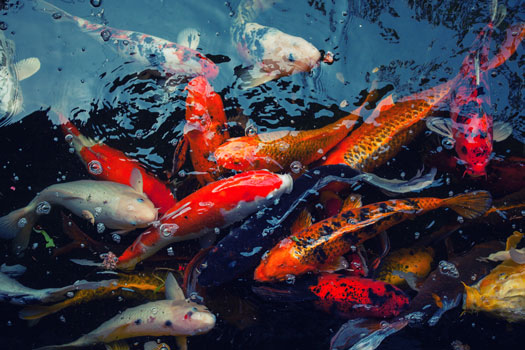- Your shopping cart is empty!
When Can You Safely Add New Fish to Your Koi Pond?

Koi are gorgeous, interesting fish that are popular in ponds. They are long-lived, with some confirmed reports of individual fish living over 100 years. The first step in guaranteeing koi have long and healthy lives is making sure the conditions in the pond are right before adding any of these beautiful fish. Don’t make the mistake of adding “feeder goldfish” to see if they’ll live or not. A lot of people do this for some reason. Feeder goldfish bring in a documented 100 different strains of bacterial and parasitic diseases. Start with koi, as they’re hardier than you might think. Here are a few things to consider, brought to you by the staff at Aquatic Warehouse, a trusted aquarium supplier and provider of pond equipment.
It Has to Be the Right Time of Year
Depending on where in the United States you live, it’s typically best to add koi to a pond in the spring or summertime, especially if the pond is new and doesn’t have an existing population of fish. Koi like to move plants and other pond features around to customize their new home to their liking, and this is easier in the warmer months when they’re more lively. The warmer water temperatures in summer also allow the koi to get used to the water quality and conditions that are unique to every pond.
The Vegetation Should Be Grown
The water plants in your pond aren’t just pretty to look at. They’ll also provide your koi with shade, shelter, and sometimes even food. The water’s surface should be about one to two-thirds of the way covered with leaves, like those of lilies, to provide shade, keep algae growth down, and help the koi hide from predators. The plants around the outside of the pond should be grown out too, as they also provide shade. Ideally, the plants on the perimeter should be kept back from the water’s edge by a few feet. You don’t want to embolden predators by giving them a comfortable hiding place.
The Water Quality Needs to Be Right
If your pond is new and you filled it with city water from your tap, you’ll want to add decholorinator that also rids the water of chloramines. In the case of well or rain water, you don’t have to worry about chlorine, but you should still test your water before adding koi. Test for ammonia, nitrate, phosphate, and pH. Invest in a good pond water testing kit. If these levels are out of safe parameters, your koi could develop serious health problems. At Aquatic Warehouse, we have great inexpensive test kits on our website to choose from:
https://www.aquaticwarehouse.com/testing-/api-freshwater-master-test-kit
Don’t forget to add fresh colonizing beneficial bacteria at the same time you purchase your koi. This is a critical mistake a lot of novice pond enthusiasts make.
If You Have to Add Koi in Cold Weather
If for some reason you have to add some koi during cold weather, be mindful of the expected temperature trend. Koi go more or less dormant during winter. They hang out near the bottom and live mostly off of stored body fat. If you live in an area with an especially cold climate, at least make sure there’s a few weeks before the pond freezes. During this time, feed the fish a high-protein fish food to help them build up some extra fat to survive the cold winter dormancy period and emerge happy and healthy in the spring.
If you need high-quality koi pond supplies, you can rely on Aquatic Warehouse to provide everything you need to keep your pond running smoothly. Call one of our pond and aquarium specialists today at 858-467-9297.
